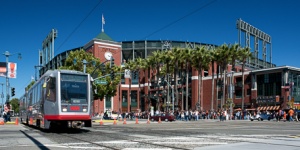Special Event and Game Day Services
Introduction
Game day and special event services are transportation services employed by agencies at a time and place that coincides with an activity that affects the travel demand of the system. Examples of such events include sports games, parades, fairs, concerts, conventions, and other sporadic, heavily attended activities. [1]
Transit Agency Strategies
Strategies that transit agencies use to improve mobility during special events include:
Motorist Information
Communicating to motorists about an upcoming or current special event can have a significant impact on local travel patterns at the time of the event. Communication techniques include (1) temporary roadway signage, (2) radio updates, (3) media partnerships, and (4) in-house information campaigns. These techniques have varying effects on travel patterns depending on whether they are employed before, during or after the event.
Traffic Management
To manage private vehicle traffic during special events, transit agencies have several tools at their disposal. Among these are (1) traffic control devices, including traffic cones, portable traffic signs, and portable traffic signals; (2) traffic patrol and law enforcement, including police and civilian patrols and traffic management teams with varying levels of authority, mobility, and coverage; (3) electronic surveillance tools, including loop detectors and video surveillance; (4) signalization techniques, including timed signalization, traffic-responsive, and metering on freeway ramps; and (5) road modifications including temporary treatments (lane closures, contraflow lanes) and permanent treatments (roadway construction, roadway expansions, intersection and interchange installation).
Travel Demand Management
Travel demand management tools in addressing special event travel demand include (1) improvements to mass transit, including new transit routes, transit-only lanes, new stations, and new ticket booths or ticket vending machines; (2) parking management strategies, including park-and-ride lots, demand-based pricing, and electronic parking guidance systems that display how many spots are available in a given location; and (3) incentives for shifting mode use or travel time, including high occupancy vehicle lanes, high occupancy toll lanes, and infrastructure improvements for people who bicycle or walk.
Together, these strategies can benefit travelers by reducing delay, reducing overall traffic demand, and improving safety. Funding for such mitigation strategies can come from several different sources. At the federal level, the most common funding sources are the Congestion Mitigation and Air Quality Improvement Program (CMAQ), the Federal Transit Administration (FTA), and the Federal Highway Administration (FHWA). At the state level, the most common funding sources are the state departments of transportation. Private partners and event organizers can also be significant sources of funding.
References
External Links
National Center for Transit Research. "Special Event Transportation Service Planning and Operations Strategies for Transit." 2006
Robbins, Derek, Dickinson, Janet and Calver, Steven. "Planning Transport for Special Events: A Conceptual Framework and Future Agenda for Research.". International Journal of Tourism Research. 2007.
Victoria Transport Policy Institute. "Special Event Transport Management." 2012.
